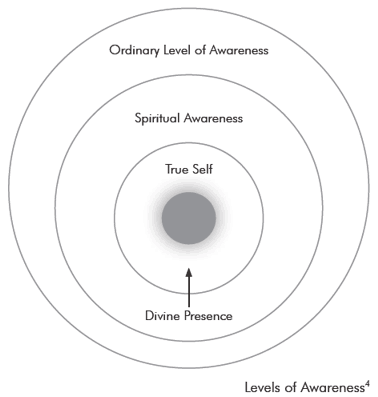Sunday, November 10, 2024
(click here to listen to or read today’s scriptures)
Centering
Blessed are the poor in spirit, for theirs is the kingdom of heaven.
In her book Centering Prayer and Inner Awakening, Cynthia Bourgeault begins by describing a movement inward with Thomas Keatings’ bulls-eye diagram called “levels of awareness.” She encourages us to practice what she calls “intentional silence,” a silence that accompanies a certain kind of prayer, which Keating calls “centering prayer.”

Praying this way is simple but not easy, because it requires patience to simply sit in “intentional” silence for 20 or 25 minutes. Try it for just five minutes. This is because our ordinary self doesn’t live in spiritual awareness.
Into our head, out of nowhere, pop random thoughts, memories, associations, and sensations.
Cynthia tested herself once, trying to concentrate and notice everything colored red in a five-mile stretch of driving. Within thirty seconds a red DQ sign caught her attention.
When I “woke up” several miles later, I realized I had been completely lost in a long reverie touched off by childhood memories of ice cream at the beach. The Buddhists smilingly call this “monkey mind.” The little beast jumps from one tree limb to the other, taking the whole of us with it.
But truly, this is the normal functioning zone of the human mind, no matter how brilliant or devout you may be. Cynthia insists we must have “spiritual training” to go deeper.
Your sense of the world and your sense of yourself will be formed at this level of awareness. Psychology and assessments like the Myers-Briggs and enneagram may yield insights into the workings of the personality, but it’s still ordinary awareness.
So what else is there down deep inside the “me” that God created, not the one I created for myself?
You might picture it as an interior compass whose magnetic north is always fixed on God. It’s as much a part of what holds you in life as your breathing or your heartbeat. But most of us are not in touch with this spiritual awareness, let alone having any idea of what it’s there for or how to use it. Our dreams are left alone to be the usual repository of our spiritual awareness.
Please don’t miss that both levels of awareness are modes of perceiving. Ordinary awareness sees how I might identify with but still know I am separate from the rest of the world, while spiritual awareness grasps the whole and provides me an “intuitive sense of belonging.” Belonging protects me from feeling isolated and anxious, often a normal part of “ordinary awareness.”
But if I’m pointed always toward “north,” toward God, does this mean that God dwells within me? Thomas Merton is sure of it.
At the center of our being is a point of nothingness which is untouched by sin and illusion, a point of pure truth which belongs entirely to God. This point, or spark, is never at our disposal, inaccessible to the fantasies of our own mind or the brutalities of our own will. This little point of no-thingness and of absolute poverty is the pure glory of God written in us. It is in everybody and if we could see it, we would see these billions of points of light coming together in the face and blaze of a sun that would make all the darkness and cruelty of life vanish completely. I have no program for this seeing. It is only given. But the gate of heaven is everywhere. (from Conjectures of a Guilty Bystander)
Keating suggests that the ultimate goal of “centering” prayer is accepting or awakening our awareness of this Presence.
More about this inner circle of the bulls-eye tomorrow.
This poor widow put more in the treasury box than anyone, because she, from her poverty, contributed all she had.”
(1 Kings 17, Psalm 146, Hebrews 9, Matthew 5, Mark 12)
(posted at www.davesandel.net)
#